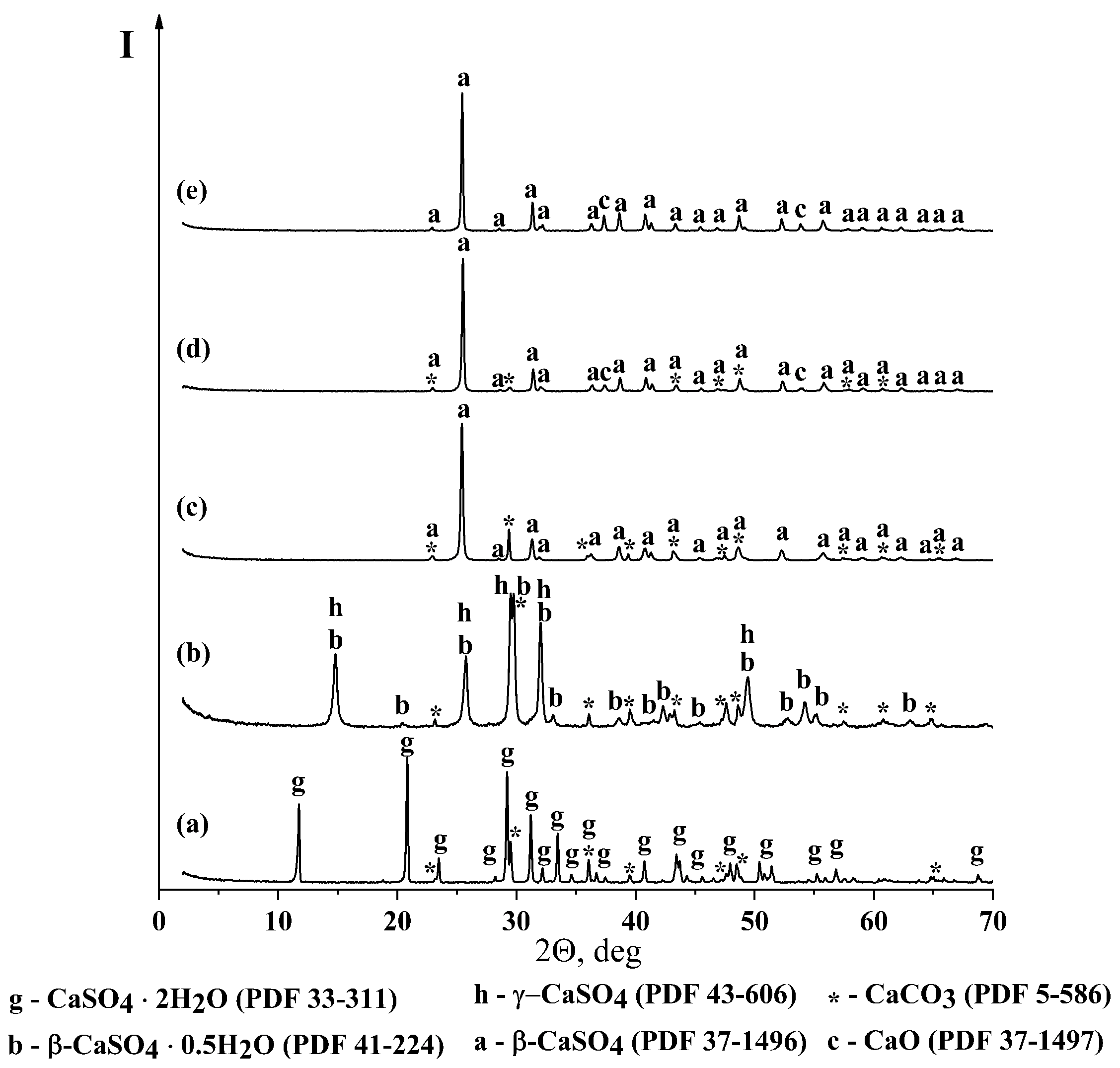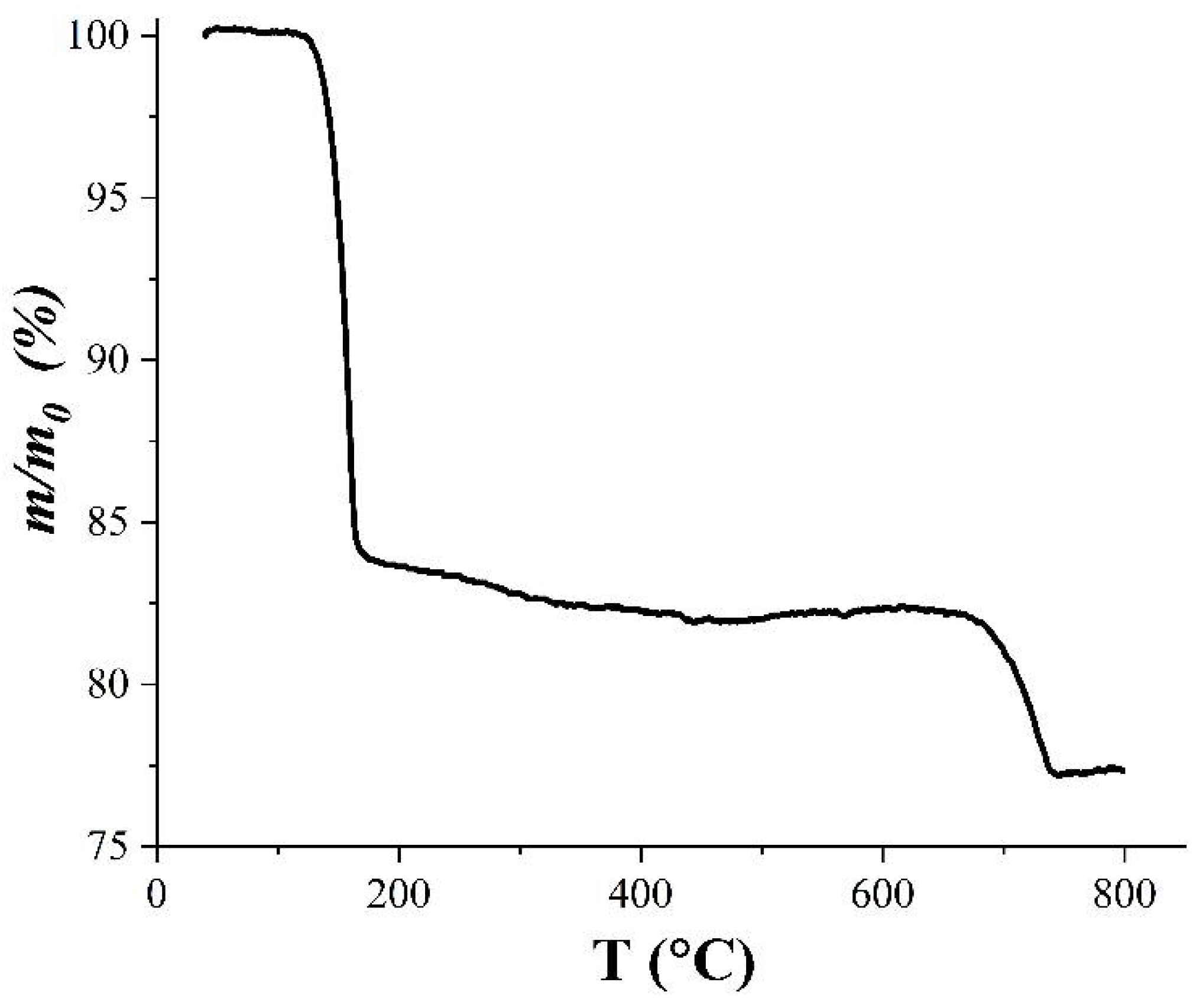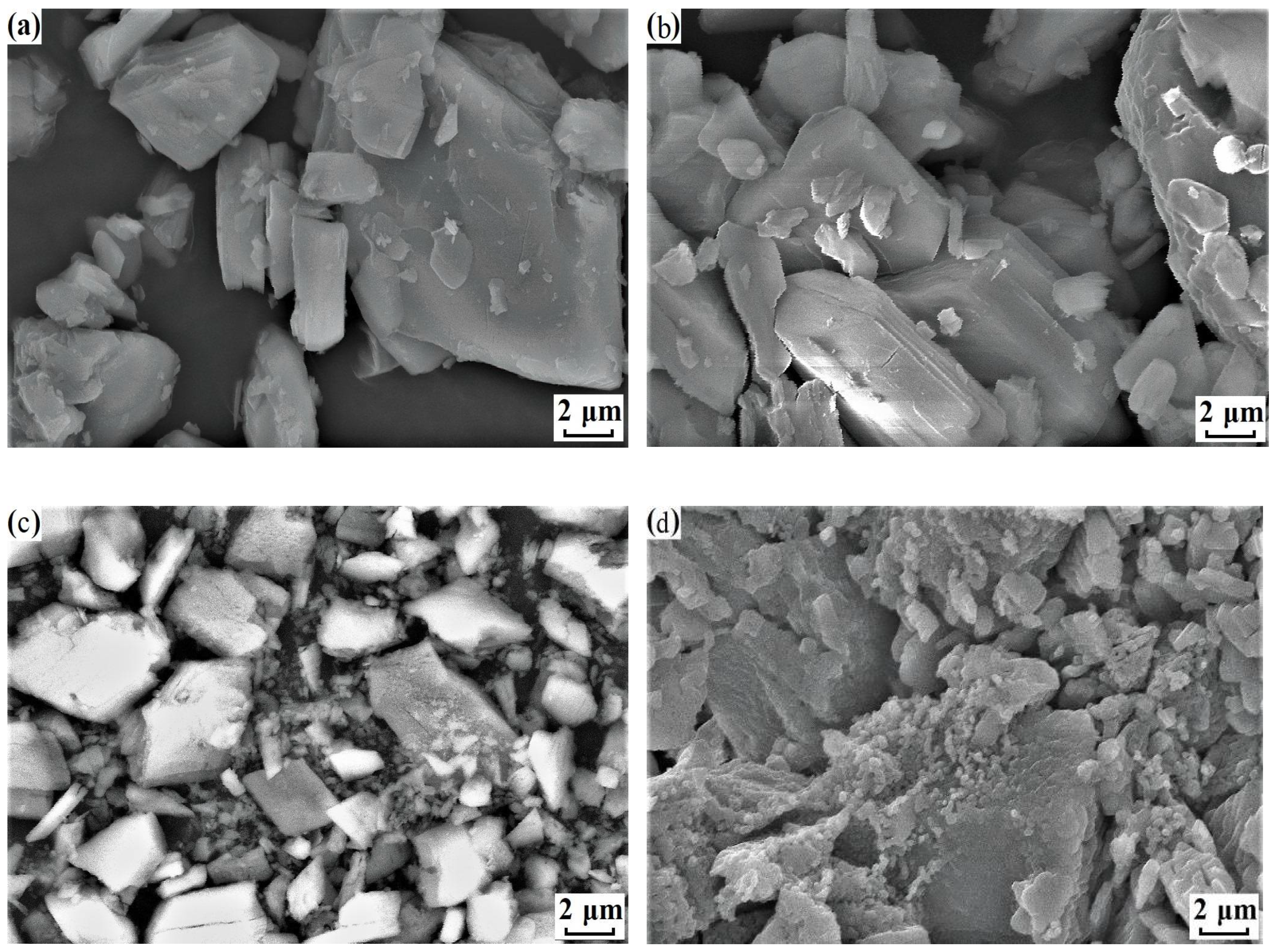1. Introduction
Calcium sulfate has been known for over 100 years [
1,
2] as a relatively cheap biocompatible material widely used for orthopaedic, dental and pharmaceutical purposes [
3]. Implants based on calcium sulfate are resorbed almost completely at in vivo assays [
4,
5] without causing inflammatory reactions. Additionally, calcium sulfate can be used in 3D printing due to its binding properties [
6].
Three crystalline modifications of calcium sulfate exist, differing in degree of hydration: dihydrate calcium sulfate (gypsum) CaSO
4·2H
2O, hemihydrate calcium sulfate (basanite) CaSO
4·0.5H
2O, and anhydrous calcium sulfate (anhydrite) CaSO
4. Dihydrate calcium sulfate CaSO
4·2H
2O is stable up to a temperature of 60–90 °C in an atmosphere of unsaturated water vapour, and it decomposes to β-hemihydrate calcium sulfate β-CaSO
4·0.5H
2O upon further heating up to a temperature of 100–150 °C. It leads to dispersing and loosening the crystal lattice that forms fine crystals of β-CaSO
4·0.5H
2O. On the other hand, dihydrate calcium sulfate can decompose to α-hemihydrate calcium sulfate α-CaSO
4·0.5H
2O in an atmosphere of saturated water vapour. In this case, the crystals of CaSO
4·2H
2O are replaced by densely packed prismatic crystals of α-CaSO
4·0.5H
2O that form large and dense crystals, having a clear prismatic habit. The structure of CaSO
4·0.5H
2O generally can be represented as a deformed monoclinic crystal lattice of CaSO
4·2H
2O. Hemihydrate calcium sulfate is metastable in water. When the temperature reaches 180–220 °C, water-soluble γ-anhydrite γ-CaSO
4 is formed, the polymorphic form of which exists up to temperatures of 300–350 °C. Further heating leads to the formation of insoluble β-anhydrite β-CaSO
4, the polymorphic form of which exists up to temperatures of 800–1200 °C. β-CaSO
4 is widely met in nature, is stable at high temperatures, and has sufficient strength for use as bone material. At temperatures above 1200 °C, β-CaSO
4 transforms into a stable polymorphic form α-CaSO
4 [
2,
7,
8,
9].
Chemical synthesis methods include various reactions and processes (precipitation from solutions, thermal decomposition, reduction reactions, hydrolysis and others). The rate of formation and growth of obtaining new-phase nuclei are controlled by changing the ratio of the number of reagents, the degree of supersaturation, the pH of solutions, the temperature of a process, etc. The coprecipitation method is a simple method for producing highly dispersed powders of various forms using catalysts, surfactants, or without them. Hence, the synthesis of calcium sulfate from aqueous solutions makes it possible to manage particle sizes and shapes, and soluble carboxylic acids in the synthesis of powders of inorganic substances may often play the role of surfactants. Thus, this work aimed to produce fine biocompatible powders from calcium lactate and ammonium sulfate aqueous solutions.
3. Results and Discussion
The XRD data (
Figure 1a) show the phase composition of the powder synthesized and dried at 40 °C. Calcium sulfate powder was predominantly represented by gypsum CaSO
4·2H
2O and calcium carbonate CaCO
3. The peaks of calcium carbonate CaCO
3 on the X-ray diffraction pattern indicate an incomplete interaction process of lactic acid C
3H
6O
3 with the original commercial calcium carbonate CaCO
3 at the stage of obtaining calcium lactate Ca(C
3H
5O
3)
2.
In a previous work [
10], it was pointed out that lactic acid C
3H
6O
3 is capable of taking part in a polycondensation reaction owing to the presence of hydroxyl (–OH) and carboxyl (–COOH) groups that allow the formation of dimers [
11] or polylactides with low molecular weight ((C
3H
4O
2)
n) [
12] from lactic acid.
Thus, the possible formation of dimers or polylactides with low molecular weight during the prolonged storage of lactic acid in turn led to the incomplete interaction of the initial reaction products at the stage of obtaining calcium lactate Ca(C3H5O3)2.
After heat treatment at 350 °C (
Figure 1b), the phase composition of the powder was represented by β-hemihydrate calcium sulfate β-CaSO
4·0.5H
2O, metastable hexagonal modification of γ-anhydrite calcium sulfate γ-CaSO
4, and unreacted calcium carbonate CaCO
3. The β-hemihydrate calcium sulfate β-CaSO
4·0.5H
2O is formed due to heat treatment in the air atmosphere, and it exists at up to 180–220 °C according to literature data. As γ-anhydrite γ-CaSO
4 is metastable in H
2O and air, it readily rehydrates to hemihydrate [
7], so that may explain the presence of β-hemihydrate calcium sulfate β-CaSO
4·0.5H
2O after heat treatment at 350 °C in the powder.
The phase composition of the powder after heat treatment at 600 °C was represented by the stable orthorhombic modification of β-anhydrite calcium sulfate β-CaSO
4, and unreacted calcium carbonate CaCO
3 was also saved (
Figure 1c).
At the temperatures of 700 °C and 800 °C, the phase composition of the powder was represented by β-anhydrite calcium sulfate β-CaSO
4, calcium carbonate CaCO
3, calcium oxide CaO and β-anhydrite calcium sulfate β-CaSO
4, and calcium oxide CaO, respectively (
Figure 1d,e).
The TA data (
Figure 2) revealed that the total mass loss of the synthesized powder heating up to 800 °C was 23% and proceeded in two stages, which correspond to the intervals of 100–180 °C and 640–750 °C.
The mass loss for the powder in the range of 100–180 °C corresponded to the decomposition of calcium sulfate dihydrate to crystalline hemihydrate calcium sulfate (reaction 2) and amounted to 16%.
It is known by literature data that further heating of hemihydrate calcium sulfate leads to a complete loss of water with the formation of polymorphic forms, firstly water-soluble γ-anhydrite calcium sulfate γ-CaSO
4, and then insoluble β-anhydrite calcium sulfate β-CaSO
4, which was confirmed by XRD data (
Figure 1b,c).
Further heating of the synthesized calcium sulfate powder led to mass loss in the range of 640–750 °C, which was caused by the decomposition of unreacted calcium carbonate into calcium oxide CaO and carbon dioxide CO
2 (reaction 3) and amounted to 5%. It was confirmed by XRD data (
Figure 1d,e). The intensity of the calcium carbonate peak (2θ = 29.4°) was much smaller at 700 °C than at 600 °C, as well as the appearance of calcium oxide CaO peaks. Increasing the temperature up to 800 °C demonstrated the complete decomposing of unreacted calcium carbonate CaCO
3, so the main phase of the powder was presented by β-anhydrite calcium sulfate β-CaSO
4, and there was a tiny amount of calcium oxide CaO too. It should be noted that there could be a contribution to mass loss by the possible combustion of the by-products of the reaction (ammonium lactate/lactic acid) absorbed on the surface of calcium sulfate particles at lower temperatures too.
According to mass-spectrometric data, the release of CO
2, H
2O and NO
2 were not recorded in the ranges of 320–380 °C, 580–620 °C and 750–800 °C. The powder after heat-treatment at 600 °C was light brown, caused apparently by the presence of decomposed organic by-products.
Figure 3 presents the photomicrographs of the calcium sulfate powders obtained after synthesis and drying at 40 °C (a), and after heat treatment at 350 °C (b), 600 °C (c) and 800 °C (d).
The synthesized and dried 40 °C calcium sulfate powder (
Figure 3a) is presented in the form of irregular agglomerates with a size of 1–10 μm. It is known that the form of calcium sulfate particles is acicular crystals. The by-product of the reaction probably present in the powder in a small amount leads to the sticking-together of the powder particles and determines the multilevel structure of the aggregates. After heat treatment at 350 °C (
Figure 3b), the microstructure of the calcined powder inherits the synthesized microstructure. After heat treatment at 600 °C (
Figure 3c), the calcium sulfate powder consists of irregular agglomerates with a particle size distribution of 1 to 6 µm that consist of smaller aggregates 0.5–1 µm in size, which are respectively composed of rhombohedral particles 100–250 nm in size. After heat treatment at 800 °C (
Figure 3d), the sintering of calcium sulfate powder is observed. The size of the grains is 100–200 nm that formed agglomerates with irregular forms.
Thus, the method considered in this work for obtaining calcium sulfate powder from calcium lactate and ammonium sulfate aqueous solutions makes it possible to produce submicron particles of calcium sulfate both after synthesis and after heat treatment.
4. Conclusions
The presented research has shown the possibility of obtaining fine biocompatible powders from calcium lactate and ammonium sulfate with different phase compositions. The powder just after synthesis and drying included calcium sulfate dehydrate CaSO4·2H2O and calcite CaCO3, and it is presented in the form of irregular agglomerates with a size of 1–10 μm. The powder after heat treatment at 350 °C, which inherits the synthesized powder microstructure, included β-hemihydrate calcium sulfate β-CaSO4·0.5H2O, γ-anhydrite calcium sulfate γ-CaSO4, and calcite CaCO3. In addition, the phase composition of powder heat treated at 600 °C, which consists of particles 100–250 nm in size linked to each other and which formed agglomerates 1–6 μm in size, was presented by β-anhydrate calcium sulfate β-CaSO4 and calcite CaCO3. Increasing the temperature up to 800 °C leads to the sintering of calcium sulfate powder consisting of β-anhydrite calcium sulfate β-CaSO4 main phase and a tiny amount of calcium oxide CaO.
The fine biocompatible powders of calcium sulfate obtained both after synthesis and after heat treatment at a temperature not above 600 °C can be recommended as a filler for producing unique composites with inorganic (glass, ceramic, cement) or polymer matrices.









